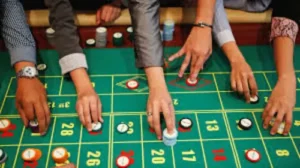Wherever your travels within Laos brings you, it’s quite certain you will stumble upon Pétanque (locally known as Petong), one of the Lao People’s Democratic Republic most popular sports. Introduced to Southeast Asia by the French, when Laos formed part of its colony Indochine, the Gallic visitors brought the game with them and the past-time gradually caught on. However, local passion for the sport was said to really ignite when Laotian Soulasith Khamvongsa took the Gold Medal (in the Doubles) at the Southeast Asian Games, held in Kuala Lumpur in 2001. Aged just 17, it was only the second time in Lao’s history the country claimed gold in the games. Since then the sport has really boomed, becoming the national sport which one can find played everywhere, by everybody.
It is a form of Boules (or ‘Jeux de Boules’, the collective French name for games played with metal balls) where the object of the game is to throw the balls as close as possible to a small wooden ball, called the jack (about 3 cm in diameter). The game is usually played on hard surfaces such as dirt or gravel but in general can be played just about anywhere, with the exception of concrete, asphalt or tiles which can break as a result of the balls being tossed on them.
The boules have a diameter between 7 and 8 cm; and ideally weigh between 650 and 800 gram.
Officially the limit to the number of participants that can play in a game of Pétanque is six. Generally, the game pits two teams against each other, consisting of one to three players. Hence, like tennis and badminton, there are singles and doubles, but unlike those sports Petong added a category, triples. In triples, each player uses 2 boules, while in singles and doubles, each player uses 3 balls. Some deviation of those rules are not uncommon, though.
The rules of Pétanque are fairly straightforward. A coin toss decides which team will choose the terrain and goes first. The team that starts the game will have one of its players draw a circle measuring not less than 35 and no more than 50 centimeters in diameter. This will be the spot every player will toss their boules from.
The first player then throws the jack from the circle to anywhere on the court, preferably between six and ten meters away and about 50 centimeters to one meter away from any obstacles, like trees or lamp posts. Any player of that team then starts with the throwing of the first boule, followed by the second team. Each player has a maximum of one minute to throw his or her boule.
Players are allowed to knock other balls away from the jack if they choose to do so. After the first round, the team that threw their boule closest to the jack is the leading team (that boule is said to be ‘holding the point’).
The trailing team then steps up and tosses their balls until one of the balls is the closest to the jack, or until their boules run out. If any of the boules hits an obstacle, that boule is considered dead and is removed from the playing field. The boules do not necessarily have to be tossed, they can also be rolled or thrown at any height.
After all boules have been thrown, players determine which ball or balls are the closest to the jack. The winner scores one point for each boule that is closer to the target than the opponent’s best boule. Only one team can score points in each round. A measuring tape (or umpire) can settle disputes between two closely positioned balls. Points are added and a new leg will begin, with the winning team starting things off with the circle drawing and first boule toss. The first team to reach 13 points (or whatever total has been decided among the teams) wins the game.
The beauty of the game is that just about anybody, regardless of age, gender, strength, height, or athletic ability can play.
If you are visiting Laos, don’t be surprised if locals ask you to join them for a game. It is great fun and an excellent way to interact with the Lao people.







